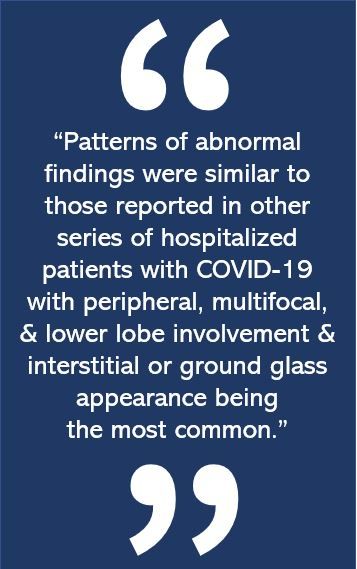Chest X-ray Findings Normal in Patients with Confirmed COVID-19
A normal chest X-ray is no guarantee that a patient is not infected with SARS-CoV-2, suggest results of a new study in ambulatory patients.

Among patients presenting to urgent care (UC) centers who had confirmed coronavirus disease (COVID-19), findings on chest X-rays were read as normal or mildly abnormal in more than half, according to a report published online April 14 in the Journal of Urgent Care Medicine.
The authors, led by Michael B. Weinstock, MD, from the Wexner Medical Center at The Ohio State University in Columbus, note that because respiratory illness in most cases of COVID-19 has a mild course, evaluations are often performed in nonemergency settings (ie, UC) and CXR is the most widely available imaging modality.
This is the first published account of imaging findings in ambulatory COVID-19 patients, according to study authors; to date the literature has focused on findings in hospitalized patients.
COVID-19 confirmed, normal CXR
The authors’ objectives were first, to determine what percentage of ambulatory patients with confirmed COVID-19 had normal vs abnormal CXRs and then to describe the frequency of specific abnormal findings on CXR.
Using the database of a large UC network in New York/New Jersey, researchers identified 718 patients with confirmed COVID-19 between March 9 and 24, 2020- the period during which greater NYC was the virus epicenter.
A total of 636 CXRs were reviewed; 57.1% were male; ages ranged from 18 to 90 years with the majority between the ages of 30 to 70 years.
⺠Analysis found 58.3% of the CXRs were normal, 89% either normal or only mildly abnormal despite symptoms at presentation severe enough to warrant CXR the UC setting.
⺠Of the 265 cases (41.7%) read as abnormal, 195 were classified as mild, 65 as moderate, and 5 as severe disease. Predominant descriptive findings reported were interstitial changes in 151 (23.7%) and ground glass opacities (GCO) in 120 (18.9%).
⺠Abnormalities were in the lower lobe in 215 (33.8%), bilateral in 133 (20.9%), and multifocal in 154 (24.2%). Effusions and lymphadenopathy were uncommon.
The authors state that the patterns of abnormal findings they did see in the ambulatory cohort are similar to those reported in published series of hospitalized patients with COVId-19, ie, peripheral, multifocal, and lower-lobe involvement and interstitial or GCO being most common.
The relative rarity of pleural effusion and lymphadenopathy also is consistent with existing studies of chest radiography in COVID-19 patients.
Study limitations include its retrospective and observational nature. Additionally, only 1 CXR was obtained for each patient and because presentations were at various states of illness, it is impossible to know whether patients with normal films at the time of imaging developed radiographic findings later in their illness.
Despite the limitations the authors suggest that a CXR read as normal in a patient suspected of being infected with COVID-19 is no guarantee that the patient is not.
For more COVID-19 coverage, visit our COVID-19 Resource Page.
Stay in touch with Patient Care® Online:
→Subscribe to our Newsletter →Like us on Facebook →Follow us on Twitter →Follow us on LinkedIn→Write or Blog for Patient Care® Online